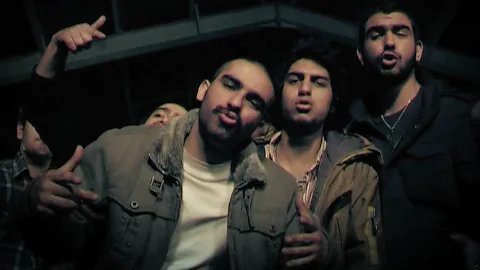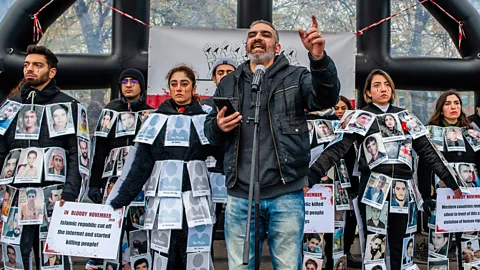Hichkas: The songs that defied the Iranian government
 Hichkas/YouTube
Hichkas/YouTubeAs Iranian rappers like Hichkas are forced into exile, and others like Toomaj Salehi and Saman Yasin are imprisoned, Arian Khameneh takes a look at the genre of music that has soundtracked an era of protest.
In the early-to-mid 2000's, Soroush Lashkari, better known as Hichkas (the Persian word for "nobody") was recording grainy rap videos on the streets of Tehran. Since he didn't have any lighting at night, he and his friends would shoot their videos by walking in front of the tail-lights of a car driving in reverse. As hip-hop is a largely illegal genre of music in Iran, he would sell his work covertly, through personal emails, attempting to screen out undercover government agents by calling buyers first and delivering CDs to their door. Despite the government branding hip-hop as "Satanism", Iranian rap spread via the internet and grew over the following decade to become one of the most popular genres of music among the country's youth, with Hichkas considered its pioneer.
More like this:
In her book Soundtrack of the Revolution, which examines how music and politics are intertwined in Iran, Nahid Siamdoust argues that the popularity of hip-hop in Iran can be linked to its connection with Iran's centuries-old poetry tradition, and rap's power of personal expression lends itself to critique and protest. Not all Iranian rap is tied directly to resistance and politics: there are lighter-themed subcategories that focus on social issues, rather than direct political critique. Today, however, as the ongoing Woman, Life, Freedom movement in Iran has heightened political tensions to a level not seen in decades, the messaging in Iranian hip-hop has become increasingly radical and rappers themselves have become some of the most celebrated and loudest political voices in the movement.
Born in Tehran in 1985, Hichkas's early socially critical work gave an insight into life in Iran, particularly of the young men of lower middle-class and middle-class backgrounds affected by devastating unemployment and a spiralling currency. With a socially realist tone, he addressed topics like poverty, corruption, inequality and oppression in the Islamic Republic era. When I first visited Iran in 2016 as a diaspora Iranian, young Iranians would play the music on their phone and recite Hichkas's lyrics as a way of teaching me about how they were really living.
 Getty Images
Getty ImagesAnother recurring theme in Hichkas's work has been the increasing censorship of artistic expression in Iran, where artists are required permits under the narrow rules of the Ministry of Culture and Islamic Guidance, which ensure that cultural works are inoffensive in the eyes of the clerical establishment. Shining a light on the impossibility of creative freedom under censorship, Hichkas asked whether Iran's revered literary works would have come to life under these conditions: "What if Hafez for his Divan, what if Rumiwindow._taboola = window._taboola || []; _taboola.push({ mode: 'alternating-thumbnails-a', container: 'taboola-below-article', placement: 'Below Article', target_type: 'mix' });
